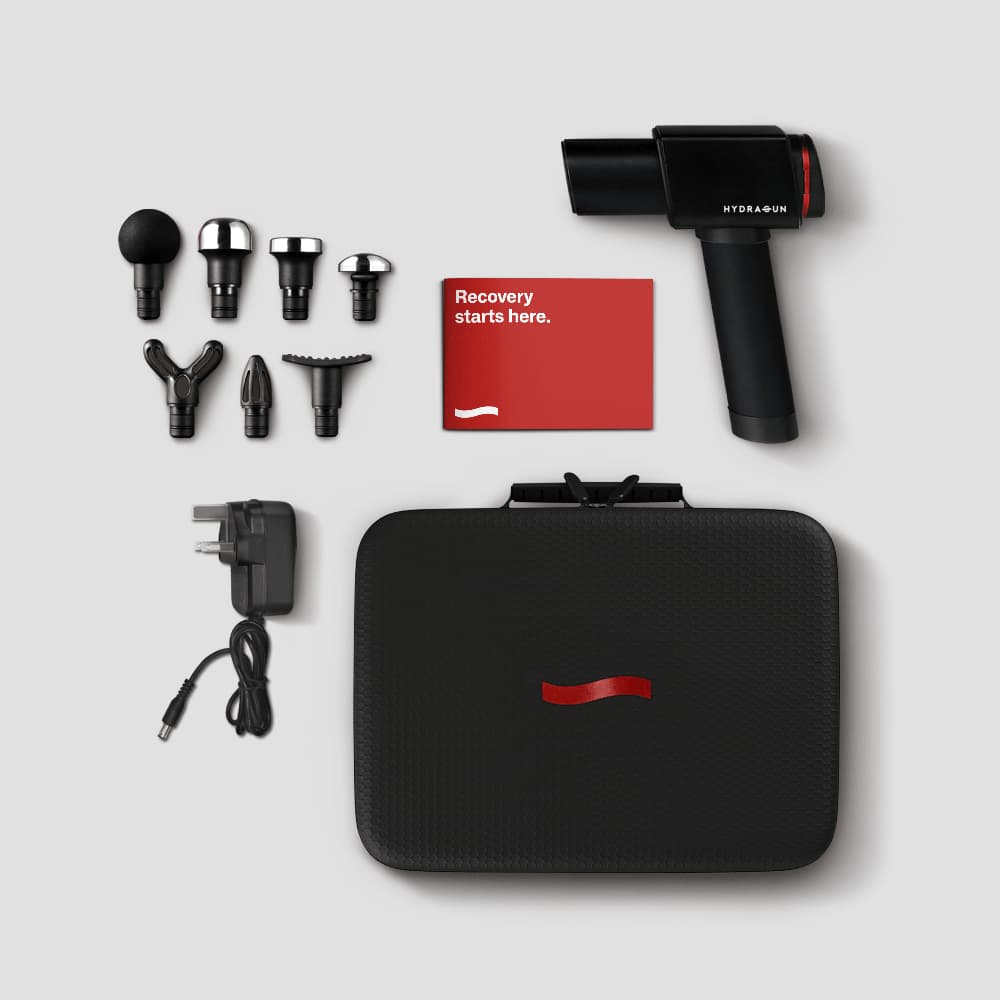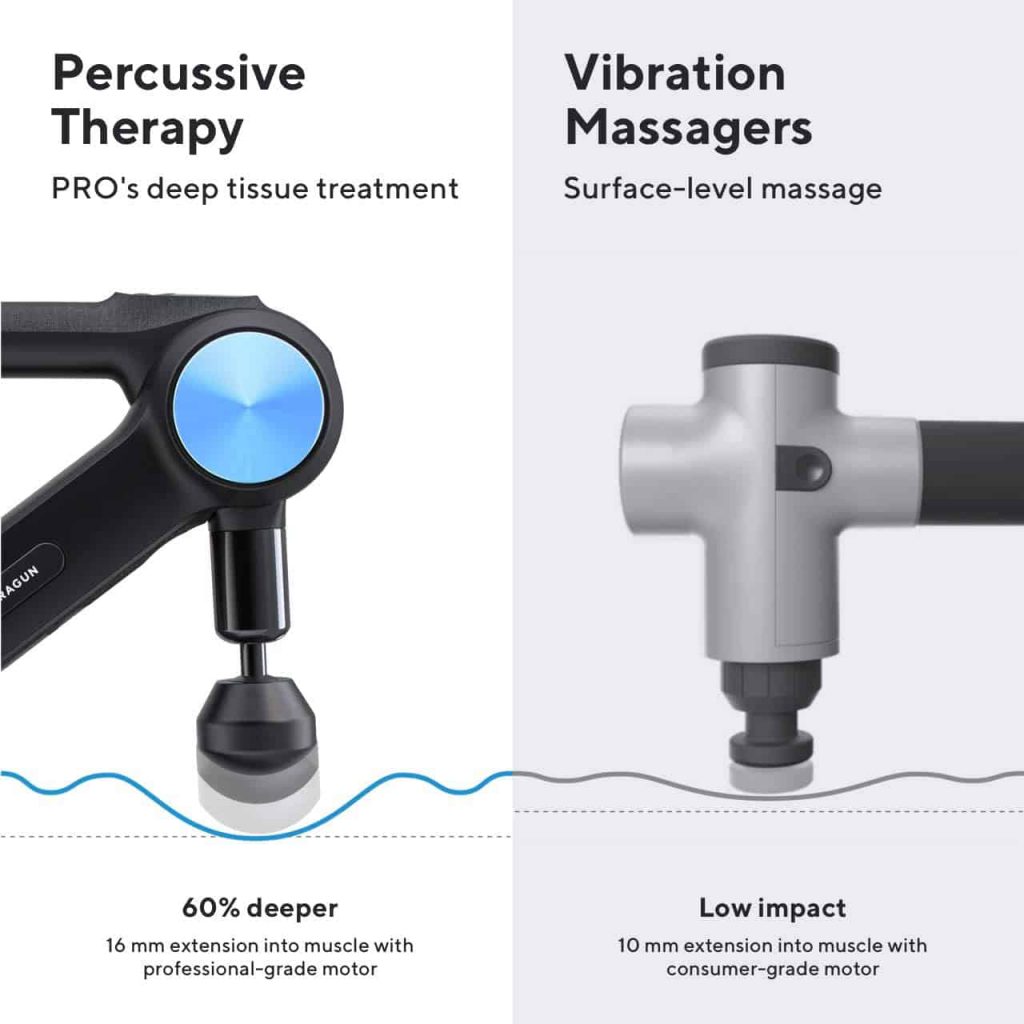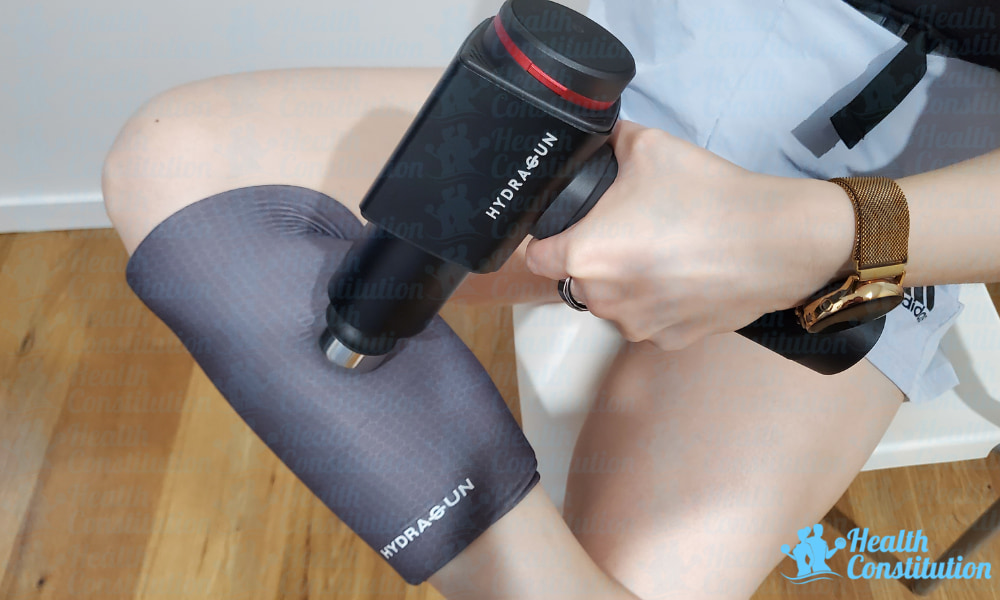Choosing a high-quality percussion massager means narrowing things down to your best options. And if your dilemma involves the Hydragun vs the Theragun G4, this comparison article should help you decide.
To keep it simple, I’ve identified the crucial factors you should consider when looking for a massage gun.
Let’s use them to find out which of these popular massage guns suits you best.
Hydragun vs Theragun G4 Massage Guns
From my perspective, I think Hydragun is a better choice for satisfying at-home massage sessions. I find its size, power and price more suitable to my preferences than the Theragun G4.
But then again, we all have different lifestyles, activities and massage needs.
Ultimately, these personal preferences will be the basis of your final choice.
So, let’s compare the two and see which of their features can provide your ideal home massage.
Check the following table for a quick rundown, or scroll further for a more detailed comparison.
| MASSAGE GUN FEATURES | Hydragun | Theragun G4 |
| Weight | 1 kg | 1.3 kg |
| Handle | Standard; silicone coated | Triangular; composite plastic |
| Attachment heads | 7 | 6 |
| Storage case | Single carrying case for the device and other parts | One carrying case for the device and a separate pouch for attachments |
| Stall force | 18 kg (40 lbs) | 27 kg (60 lbs) |
| Stroke length | 12 mm | 16 mm |
| Speed range and settings | 1200 to 3200 RPM with six levels | 1740 to 2400 RPM with five levels |
| Noise level | 50 dB | 75 dB |
| Battery type and life | 2600 mAh rechargeable battery; 3 to 6 hours | Two 16 V external lithium-ion batteries; 2.5 hours each |
| Price | Mid-range | High-end |
Design and Ergonomics
The Hydragun looks more compact than the Theragun G4. However, weight-wise, they are almost the same.
Both are not too heavy, making them easy to hold or manoeuvre with one hand.
Packing and bringing them anywhere should not be a problem, either.
These models also have the same one-button-does-all design, which is a plus for user-friendliness.
The Theragun G4 also works with a compatible app via Bluetooth.
However, pressing the button to turn them on/off or change settings can be tricky and require figuring out.
Their main difference would have to be the handle and grip, though.
Hydragun sports the standard gun-shaped handle, whereas Theragun has a distinctive triangular shape.
I like that the Theragun multi-grip design and adjustable head angle make it easier to massage and reach tough spots like your back.
The Hydragun lacks these features, but its 99-degree handle feels better on the hand.
Compared to the composite plastic handle of the Theragun, the silicone-coated grip of the Hydragun feels less slippery, too.
The soft covering somewhat absorbs the vibration produced by the device, giving you better hand control.
Winner: Both. The Hydragun and Theragun G4 are equally portable and easy to use. But I suggest identifying your usual massage points to assess whether you need a muti-grip massager.

Attachment Heads and Storage Case
The Hydragun has seven interchangeable massage heads, while Theragun G4 has six.
Both include the usual attachments that other massage gun models offer.
However, I find the massager head options of the Hydragun more varied.
Specifically, it comes with unique attachment designs, like the fork and curved heads, that the Theragun lacks.
Moreover, 3 out of 7 attachments of the Hydragun are steel. These provide deeper massages and allow the device to glide smoothly on clothes.
Hydragun also has a better storage case than the Theragun G4.
The Theragun storage bag can only fit the massager and the two batteries. Its attachments come with a separate travel pouch.
On the other hand, Hydragun’s storage case can fit the device, all head attachments and its charger, making it more travel-friendly.
Winner: Hydragun. This model offers better massage variety and storage convenience.
Massage Performance and Intensity
For this Hydragun vs Theragun G4 factor, let’s focus on three features: stall force, stroke length and speed.
You can learn more about these from my other article on how to choose a percussion massager.
But basically, these features represent the power of your percussive therapy device.
And based on the product specs, Theragun undoubtedly has higher massage power than Hydragun.
With 27 kg of stall force and 16 mm amplitude, Theragun G4 surely packs a punch.
However, note that it only has five speeds. That means the impact of each level can jump from 0 to 100, leaving little room for comfort.
On the other hand, Hydragun has a lower stall force and amplitude plus more speed settings.
These suggest that it produces more moderate massages.
Moreover, it generates a more gradual increase in intensity than the Theragun.
Winner: Both. This one depends on your needs and preferences. A Theragun G4 is ideal if you’re after deep-tissue beating. For a gentler massage experience, go for a Hydragun.

Noise
All percussive massage guns produce noise. However, some models can be very loud and distracting.
And it can be problematic if you plan to use the device in a crowded area, like a commercial gym or office.
So, if we compare Hydragun vs Theragun G4, which one is quieter? Well, Hydragun claims its device is the most noise-free model in the market.
And honestly, its 30 to 50 dB noise level is impressive, considering that this sound range is like a refrigerator hum.
On the other hand, Theragun G4 has a sound level of about 75 dB, akin to a washing machine or dishwasher.
That means Hydragun at maximum speeds is quieter than Theragun.
Winner: Hydragun. This model is the clear winner here. It’s ideal for your massage routines in public spaces. Also, a quieter device is better if you massage your neck or shoulder area often.
Battery Life
Hydragun and Theragun G4 have rechargeable batteries that you need to plug into a wall socket.
Yes, they are not for USB charging, but Theragun offers optional charging options (e.g., multi-device wireless charger, world travel charger).
As for battery life, Theragun G4 includes two swappable li-ion batteries that can last for 2.5 hours each.
Once the Theragun battery runs out, you can clip it out from the handle base and load the extra.
Considering the force of the Theragun G4, it is not surprising to see customer feedback on how quickly this device runs out of battery power.
That means you have to recharge it often and bring the extra battery when travelling.
On the other hand, Hydragun does not include a backup battery. But its 2600-mAh battery can last up to 6 hours, depending on usage.
Winner: Hydragun. The ease of charging and longer battery life make Hydragun a better choice. Also, if you travel with your massager a lot, bringing a device without the weight of an extra battery pack seems more practical.
Price
It’s hard to compare Hydragun vs Theragun G4 using the cost factor since price and promos can affect it.
But, as of this writing, there’s a $500 price gap between the two models, with Hydragun being the cheaper one.
Winner: Hydragun. After studying the essential features of both massage guns, I can say that Hydragun delivers more value for money. Its specs, quality and price are more balanced, which most customers find appealing.

Conclusion
The Hydragun and Theragun G4 are excellent choices for portable massage guns. Both have features for a quality massage. Plus, they come from reliable manufacturers.
But a closer examination of the two shows how distinct these models are.
Theragun G4 is an ergonomic device that can give you those deep-tissue massages.
These qualities are best for professional athletes and people with well-built, less sensitive muscles.
On the other hand, the Hydragun is the well-rounded one with a quiet motor and long battery life. It’s a better option from a price standpoint, too.
How about you? Which one do you think is a better massage gun? For more options, check out my list of massage gun models available in Australia.
Related Questions
1. Is Hydragun better than the Bob and Brad C2 massage gun?
Both are excellent percussive devices. But I find the lightweight and more affordable Bob and Brad C2 a better option. It’s also easier to charge through a power bank or laptop. However, the Hydragun is also a good choice if you prefer higher power, longer battery life and moderate-to-heavy massages.
2. Is it OK to use a massage gun every day?
It is generally safe to use the massage gun daily according to Ilyza Weiss, PT (2022). If you work out regularly, you can use it for up to 2 minutes per muscle group two to three times a day. Make sure to follow what the product manufacturer or your doctor recommends.
3. How should I use a massage gun for optimum results?
Start with reading and understanding the product manual. Learn how to position the device to target the correct muscle group without straining your arm. It also helps to know the best time to use the massager when working out. Lastly, follow the recommended massage time limit to avoid hurting yourself.
- Foldable vs Traditional Reformers: Which One’s Right for You? - 2 July 2025
- Elliptical Cross Trainer vs Exercise Bike: Which is Better? - 24 June 2025
- How Do the Different Massage Gun Attachments Work? - 23 June 2025
